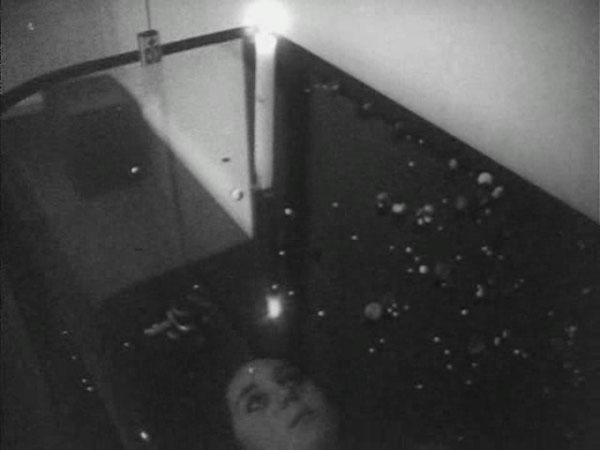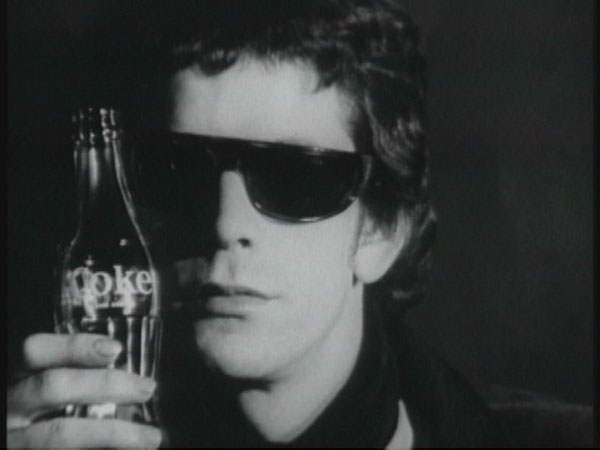Experimental shorts program at the Nashville Film Festival. Below in italics I’ve quoted their online program notes for each film and added my thoughts in regular text. Unfortunately my memory is very bad and I was neither taking notes nor concentrating on remembering details during the screening, just getting lost in the films, so my thoughts might be wrong or meaningless. I will say it was a cool program, a little saggy in the middle/end but mostly high-quality work, very enjoyable. Most of these were on video, but not the first few I don’t think.
Olivo Barbieri’s Sevilla (06) (Italy 2006,13 min.) is a tale about the perception of Europe in Africa…from the vantage point of an airplane.
Deceptive to call it a “tale” since it’s non-narrative. Also I thought it was from a helicopter – there are helicopter noises on the soundtrack (along with harsh electronic sounds coinciding with some edits, mostly near the beginning and end). I struggled throughout this one to tell if it was out-of-focus, if my eyes had gone funny, or if it’s just supposed to look that way. Didn’t know what city I was ever in, assumed Sevilla, Spain. Whether caused by the focus effect or not, it looked very much like models, a giant, detailed model city, until I’d see traffic moving. Think I liked it, anyway a nice way to start the program. I still remember the percussive music, but I bet I won’t the next time I read this. How to describe music?
Combining live action, stop-frame animation and a kinetic sculpture, Harrachov (Matt Hulse, Joost van Veen, Netherlands 2006, 10 min.) explores the effect of an arcane force that, like a black hole or an immensely powerful electromagnet, exerts a far-reaching and irresistible power upon certain objects and materials, willfully seducing, centralizing and internalizing them.
Junk moves across uninhabited ground towards a sinister shed, pulled by unseen strings, magnets, animated by stop-motion or simply tossed and rolled. Very cool movie, black and white, really brought to life by the great sound effects. We never see the final assembled creation, unless it was obscured in darkness or I blinked and missed it, but it’s shown on the website:

In The Drift (Kelly Sears, USA 2008,9 min.), a mysterious disappearance on a space journey gone awry launches the counter-cultural revolution at the end of the 1960s.
Not quite slow-zooms on still 1960’s photos, because slight motion is added to the “photos”. This one had a story and a voiceover, unusual for the program, and the woman next to me whispered “was that experimental?” From the director’s website statement: “The Drift uses frame-by-frame techniques to weave an absurd fable about our country’s unflinching frontierism and the desire to push too far, too fast. Images dug out of thrift store bookshelves and flea market bins are animated to create an alternate take on what really happened behind the face of ground control, the space program, and the American psyche.” A cool little movie about a contagious space-disease, certainly better than The Astronaut’s Wife. The drift theory would probably answer some of Werner Herzog’s questions about the inhabitants of Antarctica.
Sera Sera (John Murphy, USA 2007, 3 min.) sets atomic-bomb-testing footage to a reggae-ized version to hypnotic effect.
Director was in attendance but I had to haul ass to Phantom Love (which it turns out was cancelled, so I could’ve stayed, sorry Mr. Murphy, and sorry also for not being able to remember your film clearly but I do recall that it was short and felt like a good music video and that’s not an insult because I like a good music video). Come to think of it, the music was a trippy “que sera sera” remix. Wait, it’s coming back to me, 60’s footage treated with Tscherkasskian film-off-the-rails effects.
With water imagery as the foundation, Number One (Leighton Pierce, USA 2006,11 min.) engages the experience of elasticity between varying states of mind.
A flowing, sometimes symmetrical composition with a sliver of image in the center, and mirrored or continuous images on the left and right. And sometimes it’s something else entirely. Put me in a happy mood. Can be bought in digital form from the iTunes store.
Dig (Robert Todd, USA 2007, 3 min.) is a constricted frame in agitation, with the sweet music of jackhammers raging throughout – with intermission.
Haha, Mr. Todd, the “sweet music of jackhammers,” I get it. A desperately irritating movie about the annoyance of road construction. Actually, it’s pretty cool visually, rapid-rapid-fire shots of painted road markings spinning and sliding – would watch it again with the sound turned off. This is when people started walking out, about 3-4 per film from now until the end.

Kip Masker (Maria Petschnig, Austria 2007, 3 min.) disguises body parts in altered pieces of clothing to create semi-abstract compositions that defamiliarize the human form.
J. Schaffer says: “Soft, strained breathing accompanies the picture, intermixed with the occasional crackling of latex. From the start, I am faced with the task of disentangling the compositions magnified on screen: a hole purposely cut into a white bra with a shoulder muscle swelling over the seams? A white supporter for a packer (a silicone penis), worn the other way around?” And so on. I actually got and appreciated the intention of this film, a rarity for me. People next to me didn’t like it one bit.
The Green Bag/Documentary Happens (Tim Sharp, Austria 2007, 7 min.) is a single take, real-time documentary shot from the terrace of the Circle Hotel restaurant in Gondor, Ethiopia. While it allows a brief look at the density and multiplicity of everyday interactions taking place around the camera, the film also stimulates questions related to defining the essence of what documentary film is as a cultural artifact.
I was mesmerized by a green plastic bag blowing in the wind… dancing with me. Just kidding, I was actually bored to tears by this dull documentary by Wes Bentley, errr Tim Sharp. It stimulated questions like “when will it end?” and “how many more people will walk out?” Movie had a stunt ending: the appearance of a different-colored plastic bag. A different bag! Reminded me very much of Hidden In Plain Sight. Apparently there’s a new trend in filming stuff nobody cares about and calling it an experimental documentary. Paging Andy Warhol…
With super high-speed cinematography, reminiscent of adored science education films from our childhood, gun fetishization is taken to a surrealist extreme in Kogel Vogel (Frederico Campanale, Netherlands 2006, 6 min.).
Gun shoots bullet through glass in super-slo-mo – whoosh! Liked it, but not much there besides art-i-fying those mentioned education films.
In Ariana Gerstein’s 96 (USA 2007, 7 min.), the space between being 90 and 6 is always shifting in this moving picture portrait.
Something about photographs and a little girl? I don’t remember! I think the sensual overload of the next film acted as a memory-blanker.
Daddy I’m Scared (Tijmen Hauer, Netherlands 2006, 4 min.) is an iconoclastic video piece consisting of thirteen different children’s cartoons layered on top of one another, transforming their innocent qualities to an aggressive and mesmerizing inferno of image and sound.
Almost interesting, but the clips don’t seem to be meaningfully combined, just thrown atop each other to form a red-tinted fiery Disney nightmare. I recognized Aladdin by sound and Hunchback by visual. It was short at least.
In Light Is Waiting (Michael Robinson, USA 2007, 11 min.), a very special episode of television’s Full House devours itself from the inside out, excavating a hypnotic nightmare of a culture lost at sea.
The one I’d been looking forward to (and the reason I didn’t wander away unhappily during the green plastic bag doc) didn’t quite live up to expectations. Funnier as described to me than to actually watch. Excerpt of a Full House ep (which Katy remembers) where they drop a TV from a great height turns into SCREAMING BLINKING PAIN turns into a mirrored, folding-in-upon-itself color-tinted noisy nightmare, an extreme slow-mo excerpt from a different episode on some fantasy island (which Katy also remembers). Good move equating Full House with shrieking hell, but not actually much fun to watch. I want some Peter Tscherkassky, please.















































